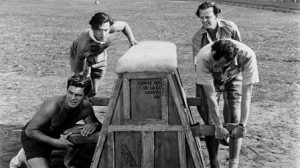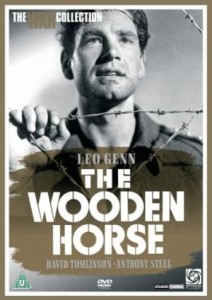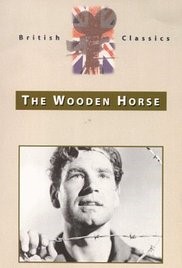The Wooden Horse **** (1950, Leo Genn, David Tomlinson, Anthony Steel, David Greene, Michael Goodliffe, Bryan Forbes, Russell Waters, Peter Finch) – Classic Movie Review 200
Director Jack Lee’s famous 1950 film is deservedly one of the best-loved escape stories of World War Two, with a screenplay by Eric Williams, based on his autobiographical book, originally written under a pseudonym of Peter Howard during wartime censorship. Captured in Germany during a bombing raid in 1942, Williams was one of the three escapees of course.
Amazingly, the events in the movie took place in the same PoW camp as those shown in The Great Escape, though in a different compound. The escape committee thought something ‘normal’ had to appear to be going on to fool the Germans, and they gave their sanction to the Wooden Horse tunnel.
Made just four years after the war ended, The Wooden Horse was filmed in Germany but in a specially built camp, as all real ones then housed displaced persons. It was supposed to be portraying events of summer 1943, but the unit was afflicted by atrocious weather, causing delays and budget worries.
There is an ideal cast, on top form. Leo Genn plays the author, here (and in the book) called Flight Lieutenant Peter Howard, Anthony Steel enjoys his breakthrough star role as Captain John Clinton and David Tomlinson is the loner, Philip Rowe.
David Greene, Michael Goodliffe, Bryan Forbes, Russell Waters and Peter Finch head the stalwart support cast in Lee’s tensely made tale of the British prisoners stuck in the German Stalag Luft III PoW camp, a place for officers run by the German Air Force. It is the Brits’ duty to try to escape. But how?
One canny officer comes up with the idea of starting daily gymnastic routines in the prison compound, using a vaulting horse for exercise. With the Nazi guards surprisingly agreeing, they place it near the heavily guarded camp boundary, and start the long, laborious process of digging a tunnel beneath it while the gym work’s going on above. There is one big problem – what to do with the earth they are removing.
Eventually the officer and two other men make their escape by using the finally completed tunnelling under the gym horse, come out to freedom at the other side. Then all they have to do is use the false passes they’ve forged and to try to reach Denmark and then neutral Sweden, hopefully with the help of someone from a sympathetic country.
This heroic, inspiring tale of victory against all the odds still comes up strong. A robust and beefy wartime adventure, this is one of the best and most influential of its now familiar kind. Of course since then it has been much parodied, along with the British bulldog spirit. But both the film and spirit it represents survive all the cynical sendups. The film’s sincerity and sense of fair play and justice combine with lots of tension and real excitement in a fine old British movie.
It goes for a low-key realist style, which is good, but slightly fictionalises the story, which is perhaps a shame. Howard and Clinton stay together and get by train to the Baltic port of Lubeck (in reality they went to Frankfurt and Stettin). Rowe travels alone as a Norwegian margarine maker and gets by train to Danzig and is the first to freedom.
In real life actor Peter Butterworth was one of the Brit PoWs who did gymnastics to cover the escapees. He auditioned for such a role in the film but was rejected because they said he was not athletic or heroic-looking enough. Michael Goodliffe (Robbie) was another real PoW.
Williams also wrote The Tunnel and The Borders of Barbarism, and died in 1984, aged 72. He was also a pretty obvious choice as the technical adviser on The Wooden Horse.
Unfairly forgotten Lee also made A Town Like Alice, Robbery Under Arms and The Captain’s Table (1958).
© Derek Winnert 2013 Classic Movie Review 200
Check out more reviews on http://derekwinnert.com







